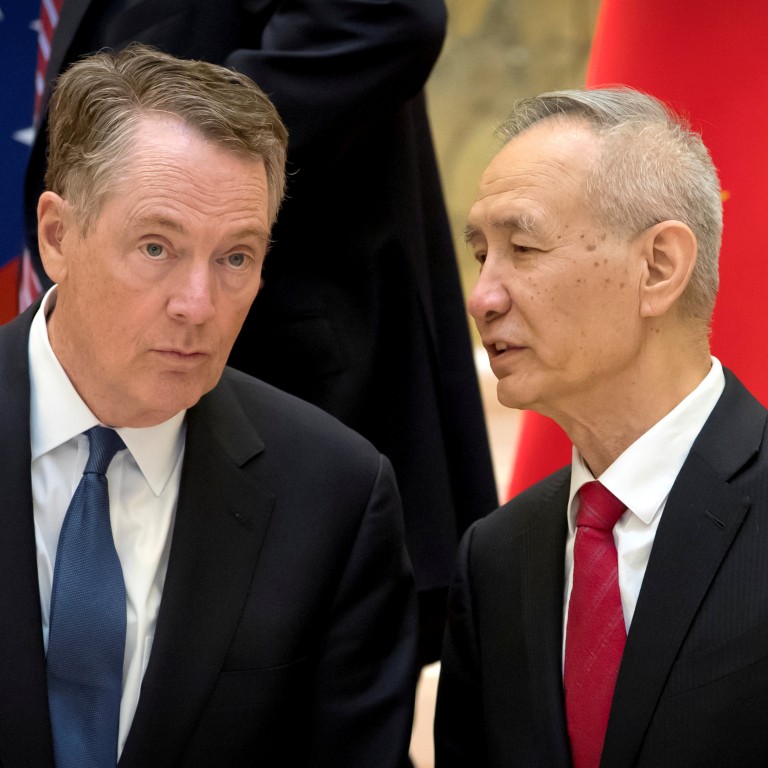
China and US map out deal to end trade war, sources say
- Top negotiators led by US Trade Representative Robert Lighthizer and Vice-Premier Liu He set to resume talks in Washington on Thursday
The United States and China have started to outline commitments in principle on the stickiest issues in their trade dispute, marking the most significant progress yet toward ending a seven-month trade war, according to sources familiar with the negotiations.
The world’s two biggest economies have slapped tit-for-tat tariffs on hundreds of billions of dollars of goods, slowing global economic growth, skewing supply chains and disrupting manufacturing.
As officials hold high-level talks on Thursday and Friday in Washington, they remain far apart on demands made by US President Donald Trump’s administration for structural changes to China’s economy.
But the broad outline of what could make up a deal was starting to emerge from the talks, the sources said, as the two sides push for an agreement by March 1.
That marks the end of a 90-day truce that Trump and President Xi Jinping agreed to when they met in Argentina in December.
Negotiators are drawing up six memorandums of understanding (MOUs) on structural issues: forced technology transfer and cybertheft, intellectual property rights, services, currency, agriculture and non-tariff barriers to trade, according to two sources familiar with the progress of the talks.
As for agriculture, the Chinese side is offering to buy an additional US$30 billion a year of American agricultural products including soybeans, corn and wheat as part of a possible trade deal being negotiated by the two countries, Bloomberg News reported, citing people with knowledge of the plan.
At meetings between US and Chinese officials last week in Beijing the two sides traded texts and worked on outlining obligations on paper, according to one of the sources.
The process had become a real trade negotiation, the source said, so much so that at the end of the week the participants considered staying in Beijing to keep working, but instead agreed to take a few days off and reconvene in Washington.
The MOUs cover the most complex issues affecting the trading relationship between the two countries and are meant, from the US perspective, to end the practices that led Trump to start levying duties on Chinese imports in the first place.
One source cautioned that the talks could still end in failure, but the work on the MOUs was a significant step in getting China to sign up both to broad principles and to specific commitments on key issues.
Chinese Ministry of Commerce spokesman Gao Feng said on Thursday that he had no information about the MOUs.
Shen Dingli, a Shanghai-based China-US relations specialist, said it would be a win for Beijing if Washington decided not to go beyond the six areas reported to be included in this round of trade talks.
“If the reports are true, Trump is cutting China some slack. These six areas are the easiest for China,” Shen said.
He said China had already showed willingness to address the six areas, including better protection for intellectual property rights, easing of non-tariff barriers and opening up of its services sector.
But it would be more difficult for China to make concession in areas such as subsidies for state-owned enterprises and internet controls.
“The negotiations will be conducted in many phases … It depends on how much Trump is willing to accept,” Shen said.
The United States has accused Beijing of forcing US companies doing business in China to share their technology with local partners and hand over intellectual property secrets, although China denies it engages in such practices.
Trump administration officials also object to non-tariff barriers in China, including industrial subsidies, regulations, business licensing procedures, product standards reviews and other practices that they say keep US goods out of China or give an unfair advantage to domestic firms.
US Treasury Secretary Steven Mnuchin has pushed for China to open its financial services markets to more foreign firms, including credit card giants Visa and MasterCard, which have waited years for China to make good on promises to allow them to operate there.
On currency, US officials including Mnuchin have warned China against devaluing its yuan to gain a competitive advantage after the Chinese currency weakened significantly against the dollar last year, partly counteracting Trump’s tariffs.
The two sides were discussing an enforcement mechanism for the deal, the source said. Reuters reported last month that the United States was pushing for regular reviews of China’s progress on pledged trade reforms and could reinstate tariffs if it deemed Beijing had violated the agreement.
The parties also were looking at a 10-item list of ways that China could reduce its trade surplus with the US, including by buying agricultural produce, energy and goods such as semiconductors, according to two other sources familiar with the talks.
Time is running short ahead of the March 1 deadline to resolve the dispute or see US tariffs on US$200 billion worth of Chinese goods rise from 10 per cent to 25 per cent.
“I think they’re trying to move fast so that doesn’t happen,” Trump said on Tuesday in the Oval Office, while not ruling out the possibility of extending the deadline.
Lower-level officials held a round of talks in Washington on Tuesday and Wednesday and they will be joined on Thursday by the top-level negotiators, led by US Trade Representative Robert Lighthizer and Vice-Premier Liu He.
Additional reporting by Catherine Wong

